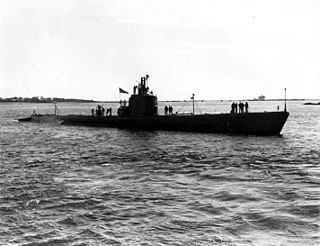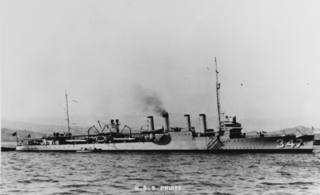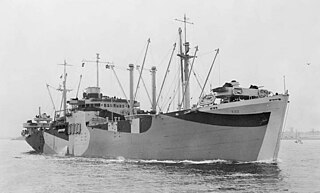
USS Runner (SS-275) was a Gato-class submarine, the first ship of the United States Navy to be named for the runner, an amberfish inhabiting subtropical waters, so called for its rapid leaps from the water.

USS Herring (SS-233), a Gato-class submarine, was the only ship of the United States Navy to be named for the herring.

USS De Haven (DD-469) was a Fletcher-class destroyer of the United States Navy, the first Navy ship named for Lieutenant Edwin J. De Haven USN (1819–1865). De Haven was the first Fletcher-class ship lost in World War II, having been in commission only 133 days.

USS Barker (DD-213) was a Clemson-class destroyer in the United States Navy in World War II, named for Admiral Albert S. Barker.

USS Pruitt (DD-347/DM-22/AG-101) was a United States Navy Clemson-class destroyer in commission from 1920 to 1945. She saw service during World War II. She was named for United States Marine Corps Corporal John H. Pruitt, a World War I Medal of Honor recipient who was killed in action Western Front on 4 October 1918 during the Battle of Blanc Mont Ridge.

USS Drayton (DD-366) was a Mahan-class destroyer in the United States Navy before and during World War II. She was the second ship named for Captain Percival Drayton, a career naval officer who served during the American Civil War.

The third USS Reid (DD-369) was a Mahan-class destroyer in the United States Navy before and during World War II. She was named for Samuel Chester Reid, a U.S. Navy officer in the War of 1812 who helped design the 1818 version of the flag of the United States.

USS Serpens (AK-97) was a Crater-class cargo ship commissioned by the United States Navy for service in World War II. She was the first ship of the US Navy to have this name: she is named after Serpens, a constellation in the northern hemisphere. Serpens was crewed by United States Coast Guard personnel and was responsible for delivering troops, goods and equipment to locations in the Asiatic-Pacific Theater.

Type C1 was a designation for cargo ships built for the United States Maritime Commission before and during World War II. Total production was 493 ships built from 1940 to 1945. The first C1 types were the smallest of the three original Maritime Commission designs, meant for shorter routes where high speed and capacity were less important. Only a handful were delivered prior to Pearl Harbor. But many C1-A and C1-B ships were already in the works and were delivered during 1942. Many were converted to military purposes including troop transports during the war.

USS LST-472 was a United States Navy LST-1-class tank landing ship used in the Asiatic-Pacific Theater during World War II. As with many of her class, the ship was never named. Instead, she was referred to by her hull designation.
USS Augury (AM-149) was an Admirable-class minesweeper built for the United States Navy during World War II and in commission from 1943 to 1945. In 1945, she was transferred to the Soviet Navy, in which she served as T-334.

USS John Penn (APA-23) was an attack transport that served with the US Navy during World War II. Named after Founding Father John Penn, a signatory to the American Declaration of Independence, she was the only ship in her class.

USS YMS-50 was a United States Navy YMS-1-class auxiliary motor minesweeper during World War II. Laid down on 16 July 1941 at Wheeler Shipbuilding Corp., Whitestone, Long Island, New York, she was launched on 6 June 1942 and commissioned on 3 August. Assigned to the South West Pacific Area she was damaged by a dive bomber while covering the landings during the battle of Arawe, New Britain on 17 December 1943. Later while covering the landings during the battle of Balikpapan, Borneo she struck a mine on 18 June 1945 at 01°18′S116°49′E and was scuttled by the light cruiser Denver.
USS SC-742 was a United States Navy SC-497-class submarine chaser which after service during World War II was transferred to the Philippine Navy in 1948.
USS SC-743 was a United States Navy SC-497-class submarine chaser which after service during World War II was transferred to the Philippine Navy in 1948.
USS LST-342 was an LST-1-class tank landing ship built for the United States Navy during World War II. LST-342 was laid down on 21 August 1942 by the Norfolk Navy Yard; launched on 8 November 1942; sponsored by Mrs. Philip H. Ryan; and commissioned on 31 December 1942.

The BX convoys were a World War II series of convoys across the Gulf of Maine from Boston to HalifaX. These convoys were escorted by the Western Local Escort Force (WLEF) of the Royal Canadian Navy to protect coastal shipping in transit between North American loading ports and trans-Atlantic convoy assembly points in Nova Scotia.

USS APc-15 was a United States Navy APc-1-class small coastal transport vessel in World War II. Laid down on 29 April 1942 as Coastal Minesweeper AMc-155 at Camden Ship Building and Marineway, Camden, Maine, she was launched on 9 July 1942 and commissioned as APc-25 on 27 October 1942.

APc-1-class small coastal transports were a troopship design used during World War 2 for the United States Navy (USN). These ships were assigned to the Pacific War where they transported supplies, personnel and munitions around the Island hopping campaign. Many of the ships were under threat of air, sea and submarine attack. A few ships of the class received battle stars for combat valor, including USS APc-15, USS APc-22, USS APc-25 and USS APc-26. The wooden-hulled ships were built by many different shipyards. Following the war, many of them were converted to fishing vessels.

Splinter fleet or Splinter navy was a nickname given to the United States wooden boats used in World War II. The boats served in many different roles during the war. These boats were built in small boatyards on the West coast and East coast, Great Lakes and the Gulf of Mexico. They could be built quickly, in just 60 to 120 days. Most of the boats were built by boatyards that already had the tools and knowledge from building yachts, sailboats and motor boats. Many were built by craftsmen in family-owned small businesses. Under the Emergency Shipbuilding Program and War Shipping Administration contracts went out to over fifty boatyards across the country. The boats were built for the US Navy, the United States Army Air Forces, United States Coast Guard, and US Army. Some of the wooden boats went to Allied nations on the Lend-Lease program.
















